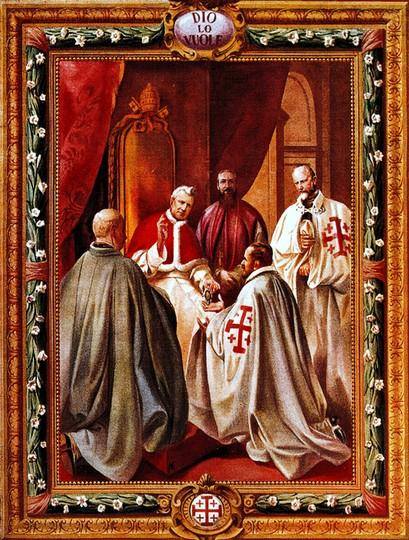The Equestrian Order of the Holy Sepulchre of Jerusalem and the Holy Land
The Terra Sancta Museum will have a hall dedicated to the history of the Equestrian Order of the Holy Sepulchre.
The origins of the Order go back to the end of the 11th century when, according to tradition, it was constituted by the crusader Geoffrey de Bouillon, the first regent of the newly born Kingdom of Jerusalem, under the title of Sancti Sepulchri Advocatus. From its foundation, the Order was composed of two branches: that of canons—first canons secular and then canons regular—charged with the care and the cultus of the Basilica of the Holy Sepulchre, and that of soldiers, responsible for the same canons and for the protection of the holy place. Thereafter, in 1103 king Baldwin I, in organizing the Kingdom of Jerusalem as a centralized feudal state like those in Europe, conceded the first privileges to the Order and defined them as “Milities Sancti Sepulchri”. With these arrangements or assises, the order adopted the Rule of St. Augustine and conferred the right to invest new knights to the Latin Patriarch of Jerusalem.

The historical evolution of both the Holy Land and the Order were always closely intertwined. In fact, when the crusaders lost their last holding in the Holy Land, the city of Acre, and after the fall of the Kingdom of Jerusalem in 1291, the Latin Patriarch was forced to retreat to Cyprus and the knights were constrained to return to Europe where they founded large priories. Notwithstanding this, pilgrims continued to arrive at Jerusalem. The Catholic Church, in fact, was still present in the Holy Land thanks to the Franciscans, who had disembarked in 1217, establishing themselves after the encounter between St. Francis and Sultan Melek Al-Kamil in 1219. Thereafter the knights would not be able to defend the Holy Sepulchre, but they would continue to carry out their important mission by protecting pilgrims en route from Europe to the Holy Land.
In 1489 the future of the Order was gravely threatened when Pope Innocent VIII, in his attempt to organize a new crusade, decided to consolidate the Order of the Holy Sepulchre and the Order of St. Lazarus into the Order of St. John. This intention provoked the protest of many European sovereigns; also since it was not supported by the Kingdom of Aragon where, thanks to Pope Alexander VI, the Order remained under the protection of King Ferdinand the Catholic of his pontiff. Finally, in 1513, Pope Leo X annulled the bull of his predecessor and annexed the Order to the Holy See, granting them a pontifical character.
Notwithstanding the absence of the Latin Patriarch, the ceremony of the investiture in loco of the knights of the Order of the Holy Sepulchre continued to be carried out thanks to the Custody of the Holy Land. This fact is reported in the famous “Libro d’Oro” which gathers the names and origins of the knights invested in the Holy Sepulchre from 1561 to 1848 and will be exhibited at the Terra Sancta Museum. Other than the book, it will also be possible to appreciate the so-called “Sword of Geoffrey,” used over the course of the centuries at the Custody during the investiture of the knights in the Holy Sepulchre.
With the aim of serving the Latin Catholics of the Holy Land, Pope Pius IX, through the bull Nulla Celebrior of 1847, re-established the Latin Patriarchate of Jerusalem and restored the Order of the Holy Sepulchre, entrusting it with the service and protection of the Patriarchate, so as to assure the support for charitable works and the diffusion of the Christian faith. Furthermore, in 1888, another historic change in the institution was ratified: Pope Leo XIII approved the request of Patriarch Gran Maestro to accept the nomination of dames to the Order.

Over the course of history, popes, kings, cardinals, nobles, and saints have taken part of this Order: St. Contardo of Este, Pope St. Pius X and Bl. Bartolo Longo; Duke Albert IV of Austria, King Eric of Pomerania, Emperor Frederick II of Ausburg, Duke Edward of Wurtemburg, King Ferdinand the Catholic, King Philip II of Spain, Louis XIV of France, Alfonso XIII of Spain, Victoria Eugenia of Battemberg and King Philip VI of Spain, who also claims the title King of Jerusalem.
From those 20 canons which constituted the Order in 1099, today it consists of more than 30,000 knights and dames spread throughout the world. These, under the emblem of the Cross of Jerusalem, maintain their thousand-year pledge to the Holy Land, promoting pilgrimage and strengthening the Christian presence through providing economic and spiritual support to the Latin Patriarch of the holy city. Moreover the Order promotes the works of the same Patriarch in Jordan, Palestine, Israel, and Cyprus, and in the other biblical lands through the Reunion of Aid Agencies for the Oriental Churches (ROACO). Finally, the Equestrian Order of the Holy Sepulchre of Jerusalem is also one of the benefactors of the Terra Sancta Museum.



